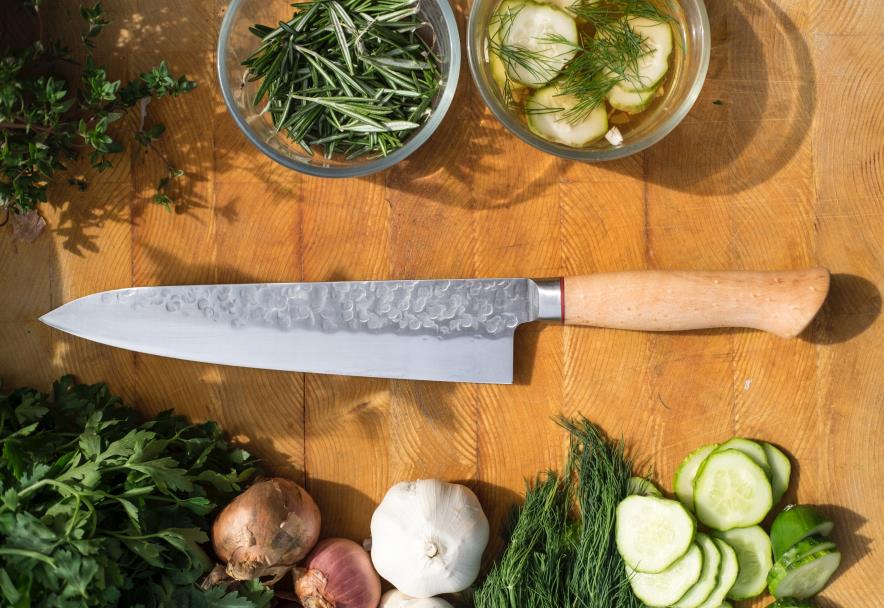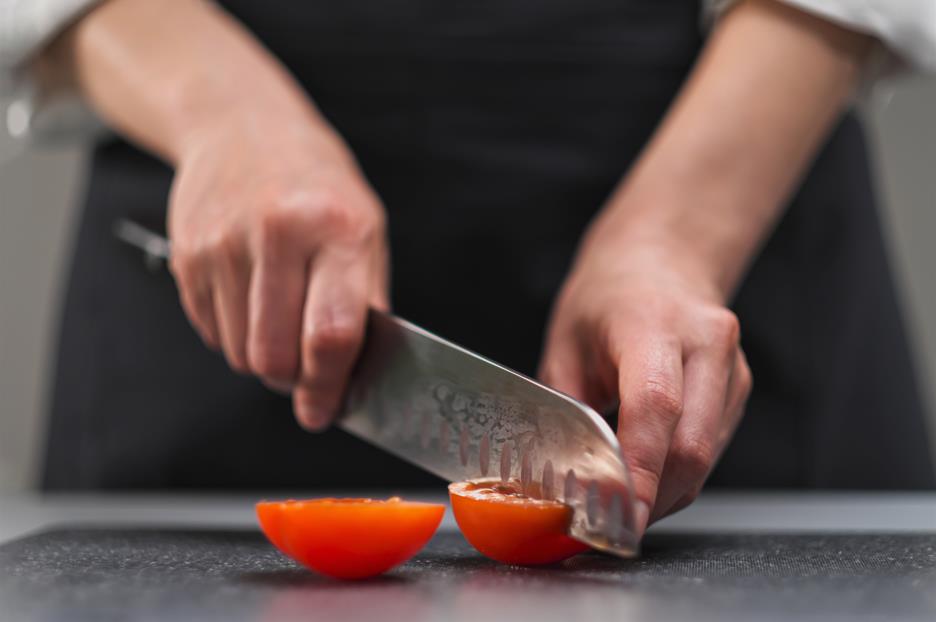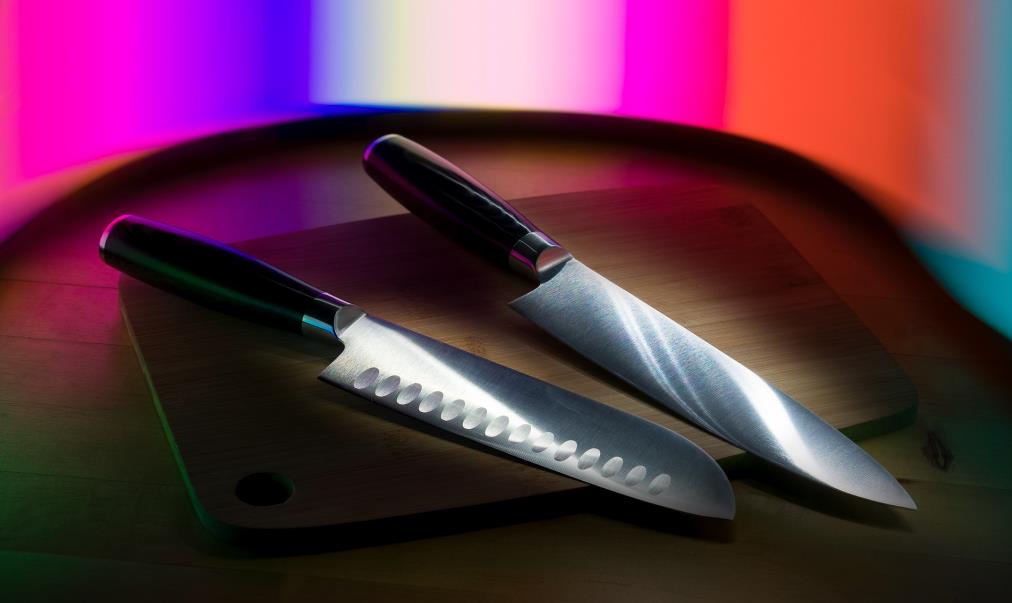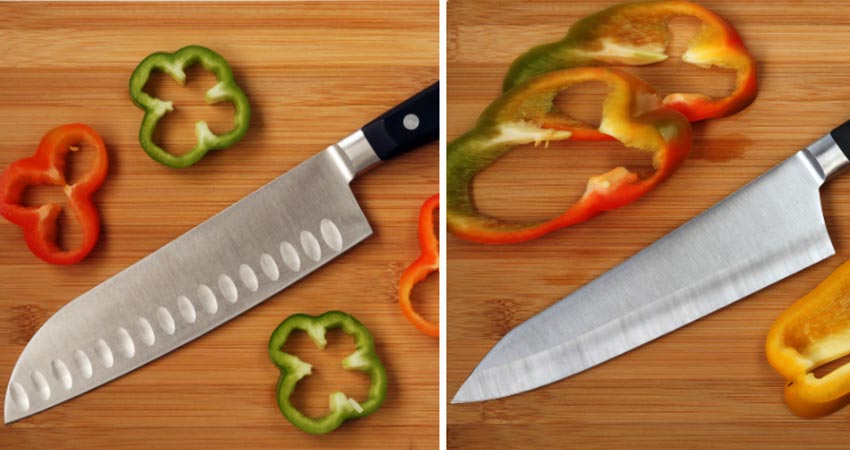Gyuto and Santoku are received as the flagship of Japanese culinary knives. They are both all-purpose kitchen knives created under the influence of Western culture. But there are some significant differences that separate them apart.
The main difference between the gyuto and the Santoku lies in the shape of the blade. The Santoku has a much straighter edge, while the gyuto has a more curved edge. It may not seem like a big deal, but this difference in blade shape affects the knife’s functionality in a big way. Santoku’s flatter edge makes it perfect for chopping or push cutting, whereas gyuto’s curved edge offers excellent rocking action for slicing.
This gyuto vs. santoku post closely examines the key differences between these two knives. We’ll analyze the origin of each knife, design, cutting techniques, and uses to help you decide which knife better suits your needs.
Table of contents
What is a gyuto?

Gyuto in Japanese means “cow sword.” It’s a general-purpose Japanese kitchen knife that resembles the Western chef’s knife. Gyutos came about between the late 19th and early 20th centuries due to the demand for a Japanese-style chef’s knife from western countries.
The demand for western knives increased as Japan began to modernize and westernize. So, the swordsmiths took inspiration from western knives and created the gyuto. We can see the similarities between the gyuto and the western chef’s knife in their shapes, sizes, and functions. The only significant difference is that gyuto knives tend to have a thinner blade and harder steel.
Gyuto knife design
The gyuto knife has a broad blade that sharply curves towards the tip. Similar to a French or German knife, it has a pointy end that’s good for precision cuts. The spine of a gyuto is flat, and the edge is often beveled on both sides.
Typically, gyuto knives measure between 5.5–10 inches. The range between the smallest and largest gyuto size is quite significant, so you can find a gyuto that perfectly suits your needs. Most gyutos have a Western-style handle, but Japanese manufacturers also make gyutos with traditional Japanese wa-handle.
Gyuto knife uses
The original purpose of the gyuto was to cut and break down large pieces of meat. But because of its versatility, the gyuto has become a popular choice for all sorts of culinary tasks. The gyuto is an all-purpose knife for home cooking and professional kitchens.
The curved edge lends itself well to a slicing motion, making the gyuto an excellent choice for cutting meat, vegetables, and fish. Because it’s heavier, breaking down tough ingredients is also a breeze.
Other uses for the gyuto knife include:
- Disjoint and debone chicken
- Boning fish
- Cutting thick vegetables
- Thin slicing of meat
- Dicing vegetables
- Creating decorative garnishes
Best Selling All-Purpose Knives
True cutting power in the palm of your hand
What is a santoku?

The name santoku means “three uses” or “three virtues.” It refers to the three cutting tasks the knife excels at: slicing, dicing, and mincing. The origin of the Santoku dates back to the 1940s during the World War II era in Japan.
Before the war, Japanese blacksmiths used to make knives specialized for each task. But the need for a versatile, all-purpose knife became apparent during wartime when resources were scarce. So, Santoku was born.
Santoku knife design
The most notable feature of the Santoku is its turned-down spine, also known as a sheep’s foot blade. Compared to the gyuto, it has a relatively shorter blade, and the edge is less curved. Because of the sheep’s foot blade, the Santoku doesn’t have a sharp tip. Still, the spine is slightly curved towards the end, giving the knife some degree of precision.
The lightweight, compact design of the Santoku makes it easy to handle. And the shorter blade gives you more control over your cuts. The Santoku typically measures between 4–7 inches, but you can also find larger sizes.
Due to the influence of Western culture, you’ll find most santokus have a Western-style handle. But like the gyuto, there are also santokus with traditional Japanese handles (wa-handle). Usually, it doesn’t have a bolster and can be single or double-beveled. Moreover, it may also have a Granton edge, a series of small divots on the blade that helps prevent food from sticking.
Santoku knife uses
The Santoku is a versatile all-purpose kitchen knife. The three most common uses for the Santoku are slicing, dicing, and mincing. But because of its versatility, you can also use the Santoku for other tasks, such as chopping and making precision cuts.
It makes an excellent choice for slicing meat, vegetables, and fish. The Santoku is also a good choice for mincing garlic and ginger. And because it’s lightweight and easy to handle, the Santoku is also a good choice for precision cuts.
Other uses for the Santoku include:
- Slicing cheese
- Mincing herbs and meat
- Scooping food off cutting boards
- Creating fine slices
- Dicing vegetables
Gyuto vs. Santoku: similarities and differences

The quest for the best all-purpose kitchen knife is often a matter of personal preference. But to help you decide, here’s a quick comparison of the gyuto and the Santoku.
Their similarities
Before we go further into the differences between these two knives, it’s important to note that the gyuto and the Santoku are all-purpose kitchen knives. So, if you’re looking for a versatile knife that can handle any task, either would be a great choice.
With the similarities out of the way, let’s look closely at some key differences between the gyuto and Santoku.
Blade design
The most notable difference between the gyuto and Santoku is their blade design. The gyuto has a curved edge, while the Santoku has a sheep’s foot blade with a straight edge. Because the gyuto’s spine is flat, it gives off a sharper and more defined tip. Meanwhile, the Santoku’s spine is slightly curved and downturns towards the end, giving it a blunt tip.
Origin
The gyuto borrows its design from Western knives, while the Santoku is a traditional Japanese knife. The gyuto was introduced to Japan in the late 19th century during the Meiji period, when Japan began to open its doors to foreigners. On the other hand, the Santoku is originally a Japanese knife popularized in the 20th century.
Culinary uses and techniques
While both knives are versatile and can be used for various tasks, they each excel in different areas. A gyuto is essentially a chef’s knife. It features a curved edge that allows for a rocking motion when cutting.
This technique involves moving the blade back and forth while maintaining contact with the cutting board. The rocking motion gives the gyuto its slicing power, making it ideal for cutting thick vegetables and fruits, slicing meat, and mincing herbs.
On the other hand, the Santoku features a much straighter edge. This edge lends push or thrust cutting techniques. Push cutting is a slicing technique that involves holding the food with your fingers while pushing the blade through it in a forward motion. This technique allows the Santoku to create very thin and precise slices, making it ideal for slicing delicate fruits and vegetables like tomatoes.
Blade length
The gyuto is the longer knife, typically ranging from 5.5 to 10 inches long, while the Santoku is on the shorter side, usually measuring between 4 to 7 inches. The extra length on a gyuto knife gives you more versatility and allows you to tackle larger tasks. The shorter blade on a santoku knife is ideal for those who want more control over their cuts.
It’s important to note that different manufacturers have different sizing conventions, so it’s always best to check the measurements before purchasing a knife.
Weight and balance
Given that different manufacturers will use different materials, it’s hard to make a blanket statement about the weight of each knife. In general, however, gyutos tend to be heavier than santokus. Finding the right balance is essential for any knife, and it’s something you’ll have to figure out for yourself.
The gyuto’s extra weight is due to its longer blade, while the Santoku’s lighter weight is attributed to its shorter length. The extra weight of the gyuto allows it to tackle larger tasks with ease, while the lighter weight of the Santoku provides more control.
Price
The gyuto and Santoku both come in a wide range of prices. You can find a decent quality knife for under $100, or you can spend upwards of $1000 for a high-end knife. It really depends on your budget and what you’re looking for in a knife. In general, the gyuto will be more expensive than the Santoku. Factors such as materials, blade length, and weight contribute to the gyuto’s higher price tag.
Gyuto vs. Santoku: comparison table
| Gyuto | Santoku | |
| Blade design | Flat spine Edges curves sharply It has sharp point | Down-turned spine Edge curves slightly Tip is less pointy |
| Origin | Late 20th century (Japan) | Late 19th century (Japan) |
| Uses | Cutting vegetables/ Deboning/Disjointing/ Dicing/Mincing/ Piercing meat. | Slicing/Dicing/ Mincing/Chopping/ Precision cutting |
| Length | 5.5 to 10 inches | 4 to 7 inches |
| Weight | Heavier than Santoku | Most are lighter than the Santoku |
| Technique | Rocking motion | Push cutting |
Gyuto vs. Santoku: which one should you choose?

Now that we know the differences between these knives, which one should you choose? We know both knives are versatile and have various uses; however, the design of each knife makes one more suitable for certain tasks than the other. For instance, the gyuto has a curved edge and a pointy tip, giving it more versatility than the Santoku.
The Santoku might be a better option if the price is a factor since it’s generally less expensive than the gyuto. So, the Santoku might be the way to go if you are on a tight budget. If you want a long knife that can handle big jobs, then the gyuto is the knife for you.
Closing
Hopefully, this article was able to help you understand the differences between a gyuto and Santoku knife. If you’re still not sure which one is right for you, it might be helpful to consult with a professional chef or someone who is knowledgeable about knives.
Whatever knife you choose, make sure to practice proper knife safety and technique to get the most out of your new kitchen tool.
You may also want to consider other All-purpose knives, such as the Serbian chef knife. If you are looking for high-quality high-carbon steel knives. Our HDMD store is the place for you.












